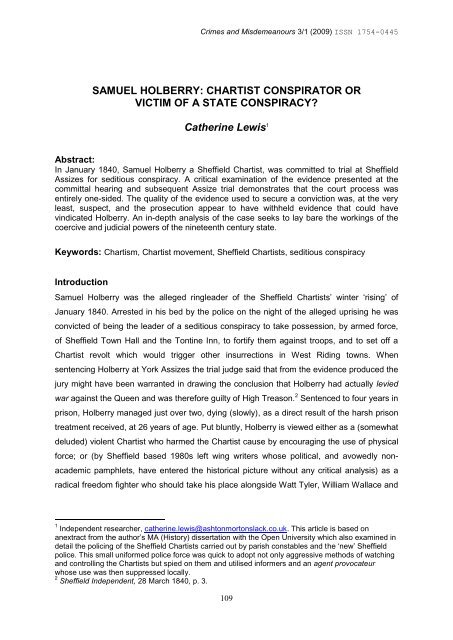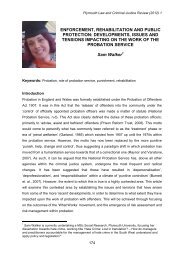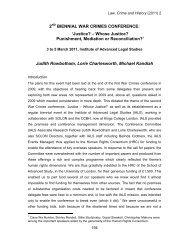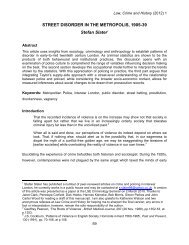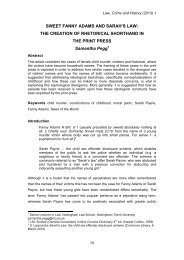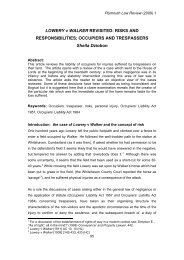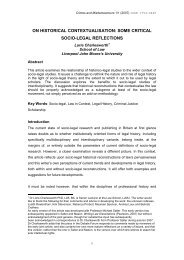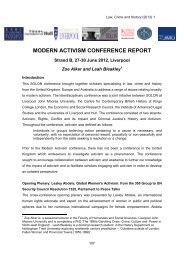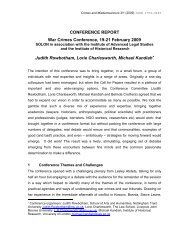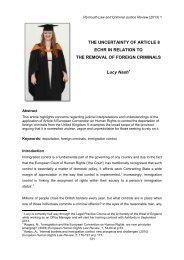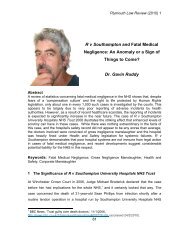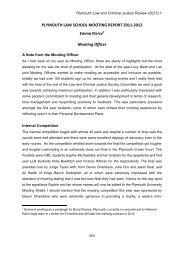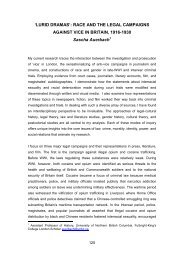SAMUEL HOLBERRY: CHARTIST CONSPIRATOR OR VICTIM OF A ...
SAMUEL HOLBERRY: CHARTIST CONSPIRATOR OR VICTIM OF A ...
SAMUEL HOLBERRY: CHARTIST CONSPIRATOR OR VICTIM OF A ...
You also want an ePaper? Increase the reach of your titles
YUMPU automatically turns print PDFs into web optimized ePapers that Google loves.
Crimes and Misdemeanours 3/1 (2009) ISSN 1754-0445How it was detected. 20 Taylor asserted that John Bland, „the active and intelligent chiefconstableof Rotherham,‟ had actively recruited one of the Chartists, James Allen, as a spy.To then gain the group‟s confidence it was „arranged‟ that Allen would declare himself asupporter of „physical force‟ and offer to bring 150 men with him at one or two day‟s notice.As soon as the time and date for the „rising‟ was disclosed, Allen went straight to the waitingJohn Bland and to Lord Howard (a Rotherham magistrate) who then galloped to theSheffield police, consequently Holberry and a few other Chartists were rounded up. Theobvious question was whether, possibly desperate to give Bland what he wanted, Allen hadexaggerated violent talk into a planned insurrection, with other „co-conspirators‟ persuadedto embellish the story and bring it to life summonsed as prosecution witnesses (who wouldescape charges if their evidence proved „satisfactory‟). Did the police uncover a conspiracyand prevent an armed insurrection? Why was Allen‟s identity and recruitment kept secret?Did the police/magistrates/prosecutors really believe that the co-conspirators, desperate toescape jail, would give only truthful evidence? It is surprising how many academiccommentators have simply accepted the police and prosecution evidence as if this wassomehow neutral without questioning the reliability or existence of any factual evidence tosupport Holberry‟s insurrection.2 Enemies of the StateAs already pointed out the use of the law to demoralise and destroy popular movements wasno new thing in the 1790s and its use continued into the late 1830s with the Chartists. Duringthis period the type of political behaviour considered to be a threat to the state changed. Theactual political expression of words and ideas was tolerated while state regulationconcentrated on the manner in which those ideas were expressed and, specifically, thethreat they posed to public order. 21 Thompson, in The Early Chartists, argues that on thewhole the authorities were fairly undisturbed by spoken or written threats by national Chartistfigures (with the notable exception of the Stephen case) 22 until the Newport rising in20 John Taylor, The Chartist Conspiracy of 1840: How it was detected (Sheffield, 1864, held atSheffield Local Interest Library, Pamphlets vol. 64/13). The paper was given to the Townhead StreetYoung Men‟s Book Society in Sheffield and later published.21 Michael Lobban, „From Seditious libel to Unlawful Assembly: Peterloo and the Changing face ofPolitical Crime c.1770–1820,‟ Oxford Journal of Legal Studies, 10 (1990) p.307.22 Joseph Rayner Stephen was a Methodist minister, noted for his radical views. He was associatedwith men like Richard Oastler, the campaigner for factory reform, and was a vocal critic of the PoorLaw Amendment Act 1834. He was also associated with the Chartist movement, owning shares in theChartist newspaper, the Northern Star, but he always rejected the label of being a Chartist. Hisinflammatory speeches and sermons, many published, led to his arrest in December 1838, chargedwith intent to disturb the peace, making a seditious speech, two counts of riot and one of beingpresent at an unlawful assembly. He was tried at Chester Assizes on 15 August 1839, convicted andsentenced to 18 months imprisonment, which he served in Chester Castle.113
Crimes and Misdemeanours 3/1 (2009) ISSN 1754-0445November 1839 when Welsh Chartist John Frost was arrested. 23 The perceived seriousnessof the Newport rising spurred the authorities in various localities including Sheffield intointensifying their efforts to find out about local Chartists which they did by increasing policesurveillance and (probably) using spies. 24 The arrest of Chartists increased dramatically andby winter 1839 their membership was confused and disorganised. 25 In the localities, short ofboth leaders and information, there was much anger about Frost‟s arrest and trial, and a realconcern with the need to maintain secrecy. It was within this immediate background contextthat Holberry was arrested.The key question is whether, as has been generally assumed by Chartist historians, theanger over the killings at Newport and the trial of Frost for treason, pushed a hard core ofnorthern militants along the road to insurrection, or whether there is at least room to doubtthe evidence for a deliberate and intended violent insurrection in Sheffield? 26 Here Saville‟sregret at the lack of studies about the interaction of Chartism with the state has real force. 27The rule of law was a potent symbol (and fiction) in the nineteenth century and the legitimacyof the court setting was a point of considerable aid for the authorities. 28 As elsewhere, theSheffield Chartists were hopelessly outgunned right from the start: judicial/legal procedureconcerned itself with the appearance of neutrality and fair play; but Holberry was denied theopportunity to either defend himself or reply positively to the evidence brought against him.Like Frost, Holberry was initially charged with high treason but at trial the charge wasdowngraded to seditious conspiracy since he had been arrested before any actual violencehad taken place. The essence of this common law offence required the perpetrator to inciteto violence with the intention of disturbing constituted authority. 29 Proof of commission wascommonly that some sort of organisation was formed in which the defendants took part andthat assertions were written or said to effect the object in question. The legal concept of aseditious conspiracy was therefore very wide. Furthermore, once the defendant was found to23 Thompson, The Early Chartists, p.18. The Newport Rising was the most serious of the WelshChartist events. The Chartist demonstration in Newport was broken up violently by the soldiery,resulting in around 22 Chartists being killed and about 50 wounded. Along with about 20 others,including the two other leaders, Zephariah Williams and William Jones, John Frost was arrested on acharge of high treason, convicted and sentenced to be hanged, drawn and quartered. However,public pressure ensured that Lord Melbourne‟s administration commuted the sentences of the threeleaders to transportation. Frost was eventually given an unconditional pardon in 1856, enabling him toreturn to the UK, though he never again lived in Newport. He died in 1877, at the age of 93.24 Ibid p.249.25 Dorothy Thompson, The Chartists (Temple Smith, 1984) p.141.26 See, for example, D G Wright, Popular Radicalism, p.123; Thompson, Early Chartists, p.18.27 Saville, 1848: The British State and the Chartist Movement, p.128 The rule of law meaning that the law was an entirely neutral and benign force, above any politicalinterference and applying equally whether rich or poor.29 See Redford v Birley (1822) 171 ER 773114
Crimes and Misdemeanours 3/1 (2009) ISSN 1754-0445be „part of the conspiracy‟ he was answerable for what took place whether or not heintended that outcome. Thus the charge could be used as a devastating weapon. CliveEmsley has described how British radicals and reformers during the 1790s believed that theywere experiencing a reign of terror and that one aspect of that terror was the use of theprosecution for sedition. 30 Most of the overtly political trials of the 1790s involvedprosecutions for publishing seditious libels or uttering seditious words. 31 Emsley argues thatthis reflected the determination of both central and local authorities to stop the circulation ofradical ideas promoting the individual as a political entity, notably Thomas Paine‟s Rights ofMan. 32During the nineteenth century, however, the state began to concern itself more withregulating the manner in which political ideas were expressed rather than regulating theexpression of the ideas themselves. Michael Lobban charts the difficult transformation fromthe punishment of words and ideas to the doctrine of unlawful assembly. 33 He argues thatprior to Peterloo „the public order issue had been the context in which to weigh up thedanger of ideas, after 1820 the public order issue took centre stage.‟ 34 Martin Wiener hasdetailed how the decades after the 1820s saw heightened concern with unregulated humanpower, both personal and collective. 35 That traditional limitations and structures of societywere being challenged and dismantled, and the advancing individualism of the age had a„dark, anarchic side that few failed to sense‟. John Belcham contends that by the time ofChartism, it was the massive occupation of public space, in what numbers and by whom,that caused alarm and transgressed elite views of order and legitimate participation. 36The main charges used against the Chartists were unlawful assembly and seditiousconspiracy. The state sought to stop or suppress large Chartist meetings in public by use ofthe crime of unlawful assembly by which the fear caused by the assembly was the decisive30 Clive Emsley, „An aspect of Pitt‟s „Terror‟: prosecutions for sedition during the 1790s,‟ Social History(May 1981), 151-175 at p. 155.31 Ibid at p.157.32 Paine himself was prosecuted for the seditious libel of publishing the Rights of Man in December1792. Paine was convicted as soon as his defence was over, the jury saying that they did not want tohear either reply or summing up. See also Michael Scrivener, Seditious allegories: John Thelwall andJacobin writing (Pennsylvania State University, 2001), pp. 1-3.33 Lobban, „From Seditious libel to Unlawful Assembly,‟ p.30734 Ibid p.350. Peterloo was the name given to the yeomanry‟s violent breaking up of a radical reformmeeting in Manchester on the 16 August 1819 at which eleven people were killed and over 400wounded, see John Cannon (ed.), The Oxford Companion to British History (Oxford University Press,1997).35 Martin Wiener, Reconstructing the Criminal: culture, law and policy in England, 1830 – 1914(Cambridge University Press, 1990), p.11,36 John Belcham, „Radical language, meaning and identity in the age of the Chartists,‟ Journal ofVictorian Culture, (Spring 2005), p.10.115
Crimes and Misdemeanours 3/1 (2009) ISSN 1754-0445factor that determined their illegality. In addition the Seditious Meetings Act 1817 preventedgroups meeting or communicating with other similar groups, the state not wanting toencourage combinations of groups with a political agenda. All these prohibitions added up toa „heavy legal constraint‟ on the Chartists who, to succeed, needed to build up a nationalmovement. 37 To be able properly to analyse Holberry‟s trial it is necessary to grasp theimportance of nineteenth century criminal procedure and rules of evidence, since it was thestate‟s tactical use of these that helped ensure Holberry‟s conviction. David Bentley hasargued that at the beginning of the nineteenth century there was much complacency aboutthe criminal trial system and that its shortcomings were numerous. These included: thepartial jury; lack of access to legal advice and assistance; lack of obligation on theprosecution to disclose any „unused‟ evidence (here bear in mind the police informer Allenand the printer Edward Smith); lack of opportunity to test and challenge the prosecutionevidence, prepare a defence and therefore answer the charges brought; and lack ofprotection from prejudicial pre-trial publicity. 38 These procedural rules were not introduced inorder to combat the Chartists; they were longstanding rules and applied to all defendants,whether charged with political crimes or not. Their operation was grossly one-sided andwhen the state (with all its resources) was driving the prosecution they allowed themarshalling of a case almost impossible to withstand.Nineteenth century rules of evidence also provide many frustrations for the modern readereager to hear both sides of the story. 39 A judicial prohibition (from the seventeenth century)against the interrogation of the accused (to avoid defendants being bullied into condemningthemselves out of their own mouths) had the extremely unfortunate consequence ofrendering prisoners incompetent to testify in their own defence. 40 Likewise they could not calla spouse or a co-accused to testify for them. Bentley notes that it was not unknown forunscrupulous prosecutors to silence potential defence witnesses by indicting them alongwith the defendant. 41 It is also clear that once in custody, isolated and without legalassistance, the police and magistrates would continue to question the prisoners. The Times,published on the Wednesday after the arrests of Saturday night/Sunday morning, informs usthat „a private examination of some of the persons in custody was entered into last night, and37 James Epstein and Dorothy Thompson (eds.), The Chartist Experience: Studies in Working ClassRadicalism and Culture, 1830 – 1860 (Macmillan Publishers Ltd, 1982), p. 360.38 David Bentley, „Trial on Indictment in Nineteenth-century England‟ (unpublished doctoral thesis,University of Sheffield, 1993), p. 4; „Acquitting the Innocent. Convicting the Guilty. Delivering Justice?‟in Judith Rowbotham and Kim Stevenson (eds.) Behaving Badly: Social Panic and Moral Outrage –Victorian and Modern Parallels (Ashgate, 2003), pp. 15-30.39 Bentley‟s „Trial on Indictment‟ is a very useful guide.40 Ibid p.3.41 Ibid p.132.116
Crimes and Misdemeanours 3/1 (2009) ISSN 1754-0445continued until near 4 o‟clock this morning.‟ 42 This was the stage when co-defendants wouldbe persuaded to turn Queen‟s evidence and testify against their associates. The (spurious)arrest of Samuel Thompson‟s father was the factor that persuaded him to turn Queen‟sevidence and Thompson‟s evidence (devastating for Holberry) bought the freedom of fatherand son.That co-conspirator‟s evidence could be exaggerated or even fabricated is beyond argumentand the possibility has to be kept in mind at all times that (at least some of) the evidence ofThompson and Foxhall was simply not true. The fate of a witness lay directly with theusefulness to the prosecution of the evidence given. A complementary freedom for theprosecutor was the power to decide who should, or should not be charged, and on whatbasis. Thompson, on his own evidence, deeply involved in the planned insurrection, wasnever charged; if he had been he would have been prohibited from testifying againstHolberry. Indeed Thompson was so actively involved in the plot that it appears to have beenassumed by some that he was a police informer. 43 On the other hand Thompson‟s fatherwas charged (on what grounds it is hard to see) no doubt to ensure that the son gave therequired evidence. Immediately after Thompson had completed his evidence the prosecutorsubmitted that the case against the father was weak and would not be pursued.Another Chartist, Samuel Foxhall, was charged but did not give evidence at committal, bythe time of trial he was out of the dock altogether so that he too could give evidence againsthis co-conspirators. Both Foxhall and Thompson were locked up together until they hadgiven evidence at the trial. 44 Under cross-examination, when asked if they had discussed thecase, Foxhall conceded „we may have said a few words.‟ While it is true to say that withoutthe use of police informers and co-conspirators the authorities would have had difficultyproving a conspiracy, what was missing was any possibility of the defendant being able tochallenge and counter the evidence. Indeed one looks in vain for Samuel Holberry‟sdefence. Where is his story, his version of events? He spoke on occasion at committal, anexchange with Thompson mentioning, perhaps, a „plan of attack‟ (what plan is unclear) buteven this is uncertain since it was reported only in the profoundly anti-Chartist SheffieldIndependent. 45 At trial Holberry was represented by a Mr Watson and therefore did notspeak. 46 Cross-examination on his behalf was minimal and it is hard to see why Thompson42 The Times, 17 January 1840, p.7.43 Sheffield Independent, 18 January 1840, p.2.44 The Times, 19 March 1840, p. 645 Sheffield Independent, 18 January 1840, p. 246 For reports on the trial see; Sheffield Independent, 21 March 1840, pp. 2-3; The Times,19 March1840, p. 6 ; Northern Star, 21 March 1840, p. 6.117
Crimes and Misdemeanours 3/1 (2009) ISSN 1754-0445in particular was not challenged as to the details of the insurrection. Had defence counselhad access to Holberry before the trial and time to prepare? It seems very unlikely. MrWatson‟s name appears regularly at this Assize as counsel for various prisoners andpresumably he received his brief at the last minute with little pre-trial access to his client(s)and little time to prepare. Holberry was effectively silenced at his own trial.3 The Trial of Samuel HolberryFollowing the arrest of Holberry at midnight on 11 January 1840 the newspapers reported ingreat and lurid detail the violent insurrection that had been narrowly averted. Yet, as amatter of fact, so little actually happened on that night that even the Sheffield Independentwas forced to admit that it is difficult to reconcile the various and conflicting details given ofthe plot. The article explains that the reason for the lack of violent Chartists present on thestreet was that „the men had not the hardihood to act out their murderous designs‟ or „it wassoon apparent that the spearmen had no stomach for the fight‟. 47 The military and policespent the whole of Saturday night/Sunday morning out on patrol keeping the town peacefuland it seems inconceivable that this state of alarm was a charade. Indeed a letter to theHome Office of 11 January 1840 from Albert Smith, clerk to the Magistrates, refers to„information received‟ to the effect that the Chartists were planning an insurrection along withother towns and that they also wanted to liberate Frost from his detention in Monmouth Gaol,where he was awaiting transportation. 48 As a result the police and military presence hadbeen increased but at that point an immediate attack was not feared. That night Holberrywas arrested, presumably after Allen had rushed to John Bland with his information. In fact itis clear from the Home Office documents that there was a generalised sense of fearthroughout the country that risings were being planned. 49 The magistrates, police and armygenuinely believed that a Sheffield rising was imminent. Yet the writer can find details of onlyeight other Sheffield men in addition to Holberry (William Booker, Thomas Booker, JohnClayton, Samuel Bentley, John Marshall, Thomas Penthorpe, Joseph Bennison and WilliamWells) who were arrested for their part in the „rising.‟ 50 Holberry was tried along with the twoBookers, Duffy and Wells, for riot and conspiracy. 51 There were it seems two or three groupsof men (Chartists?) out and about but they never engaged with the military or police, and47 Sheffield Independent, 18 January 1840, p. 2.48 NA, HO 40/57 Albert Smith (Magistrates Clerk) to Marquis of Normanby (Home Office) 11 January1840.49 NA, HO 45/102 Metropolitan police reports of Chartist meetings July 1839 to September 1841.50 These three were John Clayton, Samuel Bentley, John Marshall, with the other two arrested beingThomas Penthorpe and Joseph Bennison, The Times, 17 January 1840, p. 7.51 Others were tried later in the same Assize. William Wells, John Clayton, John Marshall, ThomasPenthorpe, Joseph Bennison, and Charles Fox pleaded guilty, something which has undoubtedlyadded to the legend of Holberry‟s guilt.118
Crimes and Misdemeanours 3/1 (2009) ISSN 1754-0445surely men armed and organised for an insurrection in a town with a known militarypresence would not have all run to ground so quickly? Both Holberry and Booker hadserved in the army and would have been under no illusion as to the difficulties they faced.The hopelessness of the Sheffield rising is commented upon as evidence of cowardice andstupidity but could there not be another explanation? That perhaps something else had beenplanned – say a show of anger at the treatment of Frost, since his guilty verdict had justbeen announced? The ‟co-ordinated risings‟ in Dewsbury and Bradford (as discussed below)suggest this possibility.Evidence at TrialA measure of the importance accorded to the trial is that it was the Attorney General whoprosecuted before Mr Justice Erskine and Mr Justice Coleridge. Of the evidence presentedthere is much that one could take issue with but space is limited. Four watchmen werecalled to report their sightings of small groups of armed men seen out and about that night.Two watchmen were injured but all reported they had seen the Chartists simply running off,even when challenged by a single watchman armed with a stick. 52 Thomas Raynor andJames Wild, the arresting officers, testified that Holberry was arrested as he lay covered onhis bed at midnight – although he was dressed. He did not resist arrest and nor did his wife,who opened the door, shout any warning that the police had arrived. When Raynor and Wildentered his bedroom on the first floor Holberry was still lying on his bed. What was he doingin bed, albeit dressed, two hours before he should have been about to start an armedinsurrection? The two constables claimed that Holberry told them he was „for physical force‟and would „kill for the Charter‟ – which he denied. To volunteer this to the police seemsunlikely. 53The main prosecution witness was Samuel Thompson, a Chartist, who paints himself asbeing actively involved in the conspiracy. He had turned Queen‟s evidence by Monday (13January); „I principally told because my father was taken up‟. 54 There is no doubt thatThompson‟s evidence convicted Holberry but it almost too convincing. His lengthy evidenceflows and is predicated on a very large factual basis about meetings, oaths taken etc. He isdetailed about grandiose plans but when explaining what actually happened or more to thepoint should have happened his evidence is weak. How, for example, were they going totackle the military? According to The Times (on this occasion taking its information from TheIris a Sheffield newspaper) there was a troop of the 1 st Dragoons on duty at the Town Hall52 See evidence of John Adcock and Thomas Hague, Sheffield Independent, 18 January 1840.53 Though it is now reported as fact in the Oxford Dictionary of National Biography, vol.27, (OxfordUniversity Press, 2004), pp. 589-591.54 The Times, 19 March 1840, p. 6.119
Crimes and Misdemeanours 3/1 (2009) ISSN 1754-0445and a troop in the yard of the Tontine Inn, with the rest, in readiness, at the barracks a mileaway from the town centre. 55 In addition infantrymen were also on duty at the Town Hall,which was also the police headquarters. These were not buildings that would have beentaken lightly. Thompson claimed 160 were to have taken the Town Hall, although on thenight only 24 materialised, and they failed to meet up with any other groups. 56The plot was this: to avoid suspicion they would advance in ones and twos on the Town Halland then at 2am rush in and assassinate every policeman and watchman they found. This isnot a plan that convinces. Holberry questioned Thompson during the committal proceedings,one of the few opportunities when he was permitted to speak. He was adamant that it wasThompson who had proposed the motion for breaking into shops and getting arms.Thompson accepts this and also that Holberry opposed it because „if the parties stopped tobreak into the shops we should lose the main object.‟ 57 The Sheffield Independent, however,then reported Holberry saying, „Do you not remember when we were alone at my house,laying down this plan of attack and wish me to bring it forward at the next meeting of thecouncil?‟ This was not reported by the other two newspapers. Was there a plan of attackand if so whose and what was it? William Wells, an 18 year old Chartist, also gave evidenceat committal for the prosecution but he knew nothing about any planned insurrection. SinceFoxhall later turned Queen‟s evidence, and could give greater detail, by the time of the trialWells found himself in the dock alongside Holberry. 58 Samuel Foxhall (Chartist) was arrestedwhen the elder Booker‟s (a co-defendant with Holberry) house was searched. He wascharged at committal but seized the opportunity to turn Queen‟s evidence. 59 He too referredto secret meetings and oaths but simply stated that while they had discussed how to take onthe military offered no specific details.Unseen Prosecution Evidence.Why was James Allen the police informer turned agent provocateur not put forward as awitness? It has been claimed that the involvement of Allen was kept a secret for 24 years. 60Yet the existence of Allen was not a secret. The Times of 17 January 1840 stated clearly„had it not been for the compunctious visitations of conscience in one of the delegates from55 The Times, 16 January 1840, p. 6.56 Samuel Thompson explains this by saying that they were sent to Water Lane when perhaps itshould have been Watery Lane, Sheffield Independent, 18 January 1840, p. 257 Sheffield Independent, 18 January 1840, p. 258 He pleaded guilty and received one year imprisonment.59 The Times, 19 March 1840, p. 6.60 Bill Moore, How the Sheffield Chartists were betrayed: being an account of a vital aspect of therising kept a secret for 24 years (Sheffield, Holberry Society Publications, undated). John Tayloraddressed the Townhead Street Young Men‟s Book Society and it was apparently printed in theSheffield Telegraph.120
Crimes and Misdemeanours 3/1 (2009) ISSN 1754-0445the Rotherham Chartists, who made the vile intentions known to Lord Howard, the townwould most probably have been sacked and burned by this time‟. 61 True, Allen is notnamed, but since he was the only Rotherham man at these secret meetings his identitywould have been obvious. Why did the Sheffield Independent connive in keeping this asecret? Did the magistrates/prosecutors/Sheffield Independent all agree that the use of apolice spy/agent provocateur would lead to riots in the town? Or was his credibility sosuspect that it would have embarrassed the prosecutors to use it? Bill Moore notes that thenext issue of the Sheffield Telegraph printed a letter from Richard Otley in reply and includedit in his pamphlet How the Sheffield Chartists were betrayed. Otley was a moral forceSheffield Chartist who claimed to have known most of those involved. He knew nothing ofAllen‟s relationship with the police and is keen to point out that far from being a mere gobetween Allen played an active part. Otley reports how Allen, in front of five or six others,called upon William Gill to take a leading part in the outbreak „which he must know wouldfail.‟ Further, that just before the arrests, when Otley was in the town centre on business, aman (who he believes was Allen) tapped him on the shoulder and said, „We are going to riseand you are requested to take a part with us and become our leader.‟The evidence given by Thompson and Foxhall was eager to stress Chartist secrecy andoaths supporting evidence of bad intent, Allen‟s behaviour itself was also very suspicious.No sensible Chartist would have been so indiscreet and foolhardy. It is reasonable tosuggest that Allen was either acting under police instruction to talk up a rising to involvemore people to arrest, or was desperate to get Chartists on the street to support hisexaggerated information. 62 Finally, we turn to the evidence of Edward Smith, the Sheffieldprinter. 63 At committal Thompson had referred to Holberry wanting to get some bills printed,„for a lecture by a Scotch delegate, on Monday night, and a sermon on Sunday,‟ but had notbeen asked to elaborate, and it is likely that he may not have known the contents of the bill. 64At the trial, from the newspaper reports examined, it would appear he said even less. 65 Nodoubt Thompson, when questioned on arrest, had mentioned these bills and the policeand/or prosecution had, quite rightly, tracked down the printer and interviewed him. EdwardSmith‟s evidence, however, would not have helped the prosecution case at all. Holberry hadtaken a document for printing on Friday 10 January to be ready for Saturday 11 January.Indeed Holberry returned on Saturday afternoon (before his arrest that night) to ensure thatthe bills would be printed and posted up around town. The deposition attached a verbatim61 The Times, 17 January 1840, p. 7 and, again, on the 18 January, p. 6.62 See, for example, the Northern Star, 11 January 1840, p. 4, which regularly warned of such risks.63 Found at the NA, TS11/816/2688, Queen v Holberry documents.64 Sheffield Independent, 18 January 1840, pp. 2–3.65 See, for example, Sheffield Independent, 21 March 1840, p. 2.121
Crimes and Misdemeanours 3/1 (2009) ISSN 1754-0445note of this bill. Entitled „Universal Suffrage v Anti-Corn Laws‟ it „respectfully informed‟ thepublic of Sheffield that on Sunday 12 January at 10am Reverend William Hill would deliver adivine service and that on Monday 13 January at 7 pm Mr Lowery (from Scotland) would beproud to meet any gentlemen connected with the Anti-Corn Law League „to discuss themerits of the Corn Law question in juxta-position with that of the franchise.‟ 66 Is this the voiceof a physical force insurrectionist? Would such an insurgent be arranging a sermon to starteight hours after a rising, followed on the Monday by a civilised debate about suffrage versusthe Corn Laws? It seems very unlikely that Holberry would have been concerning himselfwith such matters if he was intending to take any part in an armed rising. Finally the posterinforms the reader that a collection is to be made after the Sunday service towards defrayingthe expenses of Messrs Frost and Foden, (the latter was another Sheffield Chartist arrestedfor unlawful assembly in August 1839).What about the other simultaneous West Riding risings? In Dewsbury on 11 January 1840the Northern Star reported that the Frost verdict in Monmouth had caused much „sorrowingexcitement‟ and 3-4,000 people approached the town in the early hours of Sunday morningarmed with muskets, pikes and pistols firing volley after volley. 67 This „mob,‟ as describedby the Northern Star, moved on and quietly dispersed. Similarly in Bradford groups of armedChartists marched into town but again there was no attempted rising. In Bradford a delayed„rising‟ on the 27 January 1840 was betrayed by informers in the pay of the Head Constable.One of them, Harrison, had earned about £80 for infiltrating the Bradford Chartists. 68 TheBradford rioters defence counsel „ridiculed the idea of an army of less than a dozen menmarching out with pikes, and guns, and pistols, to take Bradford by storm and then toproceed to take even London itself, and to overawe the Government‟. 69 Even so they wereconvicted. Interviewed in prison a year later, William Brook was vehement about his unjustconviction at the hands of Harrison. 70The evidence would suggest that Holberry had not planned a violent insurrection for thenight of 11 January 1840. The bill he wanted printed, and the meetings he had clearlyarranged, indicate a man eager for political debate, not one interested in fighting thesignificant military presence. It is insufficient to explain the obvious lack of planning and66 NA, TS11/816/2688, Queen v Holberry deposition of Edward Smith (printer).67 Northern Star, 18 January 1840, p.1.68 Stephen Roberts, Radical Politicians and poets in early Victorian Britain: The voices of Six ChartistLeaders (Edwin Mellen Press, 1993), p. 62.69 Sheffield Independent, 21 March 1840, p. 370 NA, HO 20/10 Confidential reports, made by the Inspector of Prisons, upon the cases of all„political prisoners‟ in custody on the 11 January 1841, p. 26.122
Crimes and Misdemeanours 3/1 (2009) ISSN 1754-0445delusional aspirations as merely indicative of Holberry‟s poor „organisational ability‟. 71Maybe there was to be a demonstration of solidarity for Frost. This, it seems, is what actuallytook place in Dewsbury and Bradford. Of significant interest is not that a Sheffield‟„insurrection‟ was coldly concocted by the police and abetted by the prosecution but that itwas genuinely believed to have occurred. A form of mass anxiety, more easily generated inthe 1830s and 1840s as a consequence of large scale urbanization and industrialisation wasthat the classes lived physically separate lives, fed and in turn feeding the use of policeinformers, exaggerated media reports and cynical legal tactics to secure arrests, evidenceand conviction. The Chartists, denied any legal method of operating politically, andprosecuted liberally throughout the late 1830s to early 1840s, would have considered, surelycorrectly, that the State was bent on destroying them.ConclusionAn analysis of the events leading up to Samuel Holberry‟s arrest and his subsequent trialthrows into relief the operation of the coercive and judicial powers of the State. Holberry wasa Chartist, implicated by a police informer and then prosecuted by the Attorney General.The Sheffield Police were a small force in 1840 and had only been a full-time and uniformedforce for just over three years. As well as responsibility for watching they were alsoresponsible for lighting and cleansing. Yet during these summer months of 1839, when therewas much Chartist agitation, they quickly adopted quasi-military methods, patrolling with thearmy and chasing down retreating groups of Chartists through the narrow alleyways wherethe cavalry could not follow. They were not a neutral force; they allied themselves very firmlywith the authorities, which is hardly surprising as they were paid for by the same localratepayers who felt threatened by the Chartists. At times there seemed little, if any,distinction between the military and the police presence and such anger was roused againstthem that for a while they patrolled armed with cutlasses. The police were also quick to spyon the Chartists at both their public and private meetings, either listening in themselves orpaying, or pressurising, others to attend, listen, and report back. This was undertaken bothopenly and surreptitiously. The authorisation, by the Chief Constable of Rotherham, of theemployment of Allen as a police informer turned agent provocateur transgressed theboundaries of discretion still further and it was as a direct result of Allen‟s „intelligence‟ thatHolberry was arrested and an insurrection alleged.Once Holberry and a few other Chartists had been arrested, they were kept isolated incustody, and without legal advice or assistance the police and magistrates continued to71 Thompson, Early Chartists, p. 250.123


